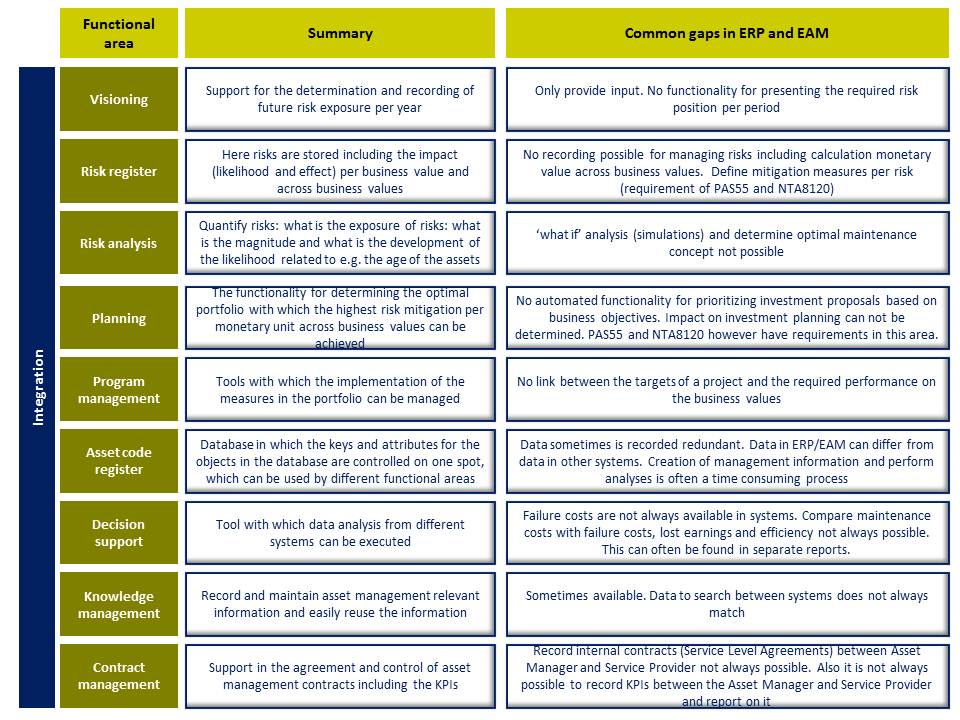| |
Fill information gaps for the Asset Manager
18 November 2011 • John de Croon
asset management strategie, risk management, policy development, planning, program management, manage changes
Many companies have implemented an Enterprise Resource Planning (ERP) or Enterprise Asset Management (EAM) system[1]. These are systems for an automated support of many company processes. The functionality covers areas such as Finance & Control, Human Resources Management, Project Management and Maintenance. ERP and EAM systems do not support all processes for an Asset Manager. Companies that develop themselves in the asset management area have a growing need for information. One of the major changes is the importance of information in decision making. In the past there used to be a strong human touch in every step and at many companies this is still the case. Many decisions are taken simultaneously by one person in the preparation of a plan, and not distributed over time and people like it happens when a designer / planner / work preparator takes many decisions. Automated support could help in such a case. Niche software tools often contain the functionality. Companies sometimes want to purchase those tools and then think that a gap is filled. But with the introduction of those niche tools, issues arise such as the integration of data. How should a company deal with it?
In the figure below functional areas for the Asset Manager can be seen, which could be connected to each other via an automated integration layer. In a number of functional areas often gaps exist. If ERP and EAM systems have gaps, this in itself is not a problem. The strategy of the suppliers of these systems is to provide the core functionality with which most of their customers can support the majority of their processes. The asset intensive sector sometimes is only a small part of the entire market of ERP and EAM vendors and the asset intensive sector is also diverse. Niche vendors have responded by delivering specific products such as risk registers[2], tools for determining maintenance concepts and prioritization tools for management. These products may also take the diversity of the asset intensive market into account and can be industry specific.
In their enthusiasm to improve, companies sometimes buy tools on an ad hoc basis. This is not always without problems. Problems could exist in the integration of data between the ERP or EAM system and the niche tools (both between ERP / EAM and the niche tools as well as between niche tools themselves). The systems often do not properly connect or there is no unambiguous redundant data. The lack of standardization within organizations is an obstacle for asset management (source: The state of Asset Management in the Netherlands. Y.C. Wijnia, P.M. Herder. World Congress on Engineering Asset Management, 2009).

Therefor it is not surprising that for proper asset management an organization should ensure consistency of data[3]. Often the data often is present in the minds of people instead of systems and the ownership of the data is not properly defined. If organizations wish to develop further in asset management, it is very important that information management is organized. Then the question arises what information management is all about. Information Management consists of two parts.
First, a unified data model needs to be set up (e.g. an entity can have only one interpretation), which must also be managed. It means that the model should be consistent (free of contradiction) and the model must be very flexible. Changes in the organization must have a minimal impact on the model. Furthermore, it should be possible to exchange data between different organizational entities and each entry can only have only one owner.
In information management it is also essential that the roles and responsibilities are defined and implemented for managing the data. After all, what sense does it make to set up a nice data model, when nobody feels responsible for the quality of the data?
Ergo: if a company wants to develop, then to implement niche asset management tools is an important step. However, if this is accompanied without a clear data model and the roles for the correct delivery of data are not implemented, it is like a frame in a museum without a painting. That is the equivalent as to burn money and this is no proper asset management.
[3]The asset management standard NTA8120 required it explicitly
John de Croon is partner at AssetResolutions BV, a company he co-founded with Ype Wijnia. In turn, they give their vision on an aspect of asset management in a weekly column. The columns are published on the website of AssetResolutions, http://www.assetresolutions.nl/en/column
<< back to overview
|


